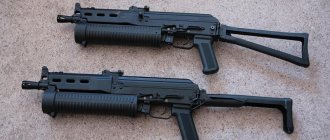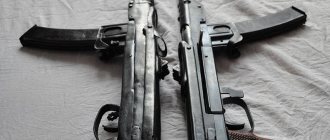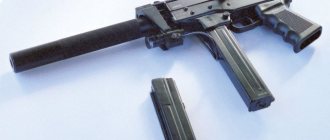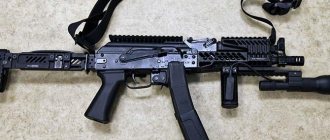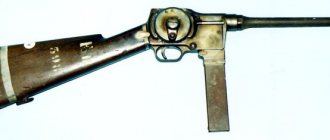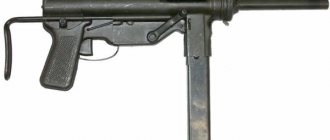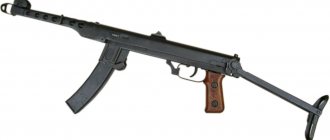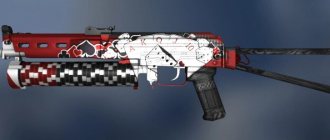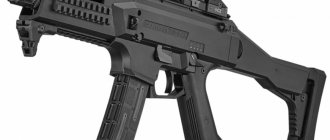Submachine gun STEN MK 2. Device. Weight. Dimensions
World War II was a war of technology. It once again clearly showed that battles are won not only on the battlefield. An equally important role was played by correspondence battles between designers on both sides of the front line. But there was another side to this war - the war of the special services. Scouts obtained the most important information about the enemy's plans and technical documentation, saboteurs destroyed military facilities, equipment and the most prominent figures of the enemy.
STEN MK II submachine gun - video
One of the first special units in world history were the British “commandos”. This unit was distinguished by amazing mobility and the highest professionalism; It is not surprising that he was entrusted with tasks that were beyond the capabilities of anyone else. There is nothing strange in the fact that completely unique weapons were developed and produced to arm this and other similar units around the world. At the beginning of the Second World War, the armed forces of the United Kingdom found themselves virtually without submachine guns. Domestic Lanchesters were far from perfect; Quite a significant part of them were also lost during the retreat from Normandy in 1940. The American Thompson M1921, although convenient in battle, remained quite expensive; in addition, ammunition for them had to be supplied from overseas.
Submachine gun STEN Mark 1 (STEN Mk.I)
In 1941, the production of its own British design, STEN submachine guns, began. The weapon got its name from the first letters of the surnames of its developers R. Shepherd and G. Turpin and the name of the development company - Enfield. British designers completed the task in record time - 30 days. The new weapon immediately became extremely popular due to its simplicity and reliability. British industry produced a huge number of these submachine guns. Not surprising, especially considering that the production cost of a regular STEN at that time was a little more than $5, while the market value of the American Thompson M1921 was almost 40 times more. It was possible to repair STEN with only a minimal set of tools at hand. From all of the above, it becomes clear why the new weapon received the affectionate, but slightly ironic nickname “tin” from the soldiers. Soon the submachine gun was modernized, and an even simpler, but equally reliable modification, the STEN Mk II, went into production.
Submachine gun STEN Mk.II (STEN Mark 2)
It is not surprising that the British commandos ordered a special version of the popular weapon. Soon the order was completed, and the commandos received a quiet STEN. Technically, STEN Mk II S is practically the same STEN Mk II, only with an integrated silent firing device. The STEN Mk II barrel had to be shortened by almost half. By reducing the muzzle velocity of the bullet, British designers significantly increased the life of the silencer. The range of effective fire was also reduced and amounted to a maximum of 100 m, but this was quite enough to perform the tasks for which this weapon was intended.
STEN Mk.II S submachine gun, equipped with an integrated silencer
uCrazy.ru
- Warm cat
- 17 November 2007 16:28
- 3236
They say that the reasons for the creation of the STEN submachine gun should be sought in the Dunkirk disaster.
They say that the army fled from France even without personal weapons, and it should have been urgently rearmed. Many believe that the British were not satisfied with the Thompson submachine gun, a legendary weapon glorified in gangster films, but quite complex, and, if you take into account transportation across the ocean, also expensive. In addition, after the attack on Pearl Harbor, the United States also found itself drawn into the war, and the manufacturing country now needed weapons. We should also not forget that in 1940-1941 the British Isles were expecting an invasion, so everything that could shoot was prepared for battle. It was necessary to arm a lot of people, preferably even housewives, and come up with a design that a patriotic Briton could make in his workshop. Looking ahead, it should be noted that the designers coped with this task so brilliantly that sometimes the Maquis detachments were not given weapons, but drawings. Indeed, it was a weapon that was made from water pipes. Initially, the British tried to copy the German MP-28, a simplified copy was called “Lanchester”, but it soon became clear that mass production of such a weapon could only be a dream. So, the basic STEN model was developed by Major Reginald W. Sheppard and Mr. Harold John Tarpin in a month and consisted of 47 parts. As can be seen from the ranks, Sheppard was a military officer, Inspector of Armaments in the Ministry of Supply Design Department at Woolwich Arsenal, and later Assistant Chief Superintendent at the Armaments Design Department. Tarpin is simply an engineer at the Royal Small Arms Factory. It was planned that the production of this weapon would continue for two years. Production was mastered at the Royal Small Arms Factory in Enfield, near London. It was from the beginning of the three personal names Sheppard, Tarpin, Enfield that the name of the weapon was formed - STEN. The submachine gun did not require expensive materials. Most operations were performed on lathes and drilling machines. Milling was needed only for four grooves on the bolt. Everything else can be done using a regular vice, a hacksaw, or a file. Welding in some places could be replaced by soldering. The labor intensity of the basic STEN Mk 3 model was 5 man-hours. For some reason, in English documentation this weapon was referred to as a carbine, although the weapon was a typical submachine gun, called in English “subamachine”, or “subamachine gun”, abbreviated SMG. Principle of operation. In appearance, the STEN bolt is very similar to an enlarged copy of the German MP-40 bolt. The shutter is open, that is, in the cocked state, it is on the sear. When the trigger is pressed, the trigger lever deflects the sear down. The bolt is released, picks up a cartridge from the magazine, sends it into the barrel, and punctures the primer. A shot occurs. The recoil cocks the bolt and the cartridge case is ejected, reflected by the magazine. The first drawback of the weapon is buried here - poor accuracy. When moving, a massive bolt disrupts the aiming line and changes the balancing of the weapon. The accuracy of "closed bolt" weapons is generally higher. However, it was believed that the accuracy was fully compensated by the rate of fire. There was a switch for automatic and single fire. During a single fire, pressing the trigger removed the sear from the receiver and the bolt was released. However, after walking a few centimeters, the ledge on the shutter pressed the trigger lever down, releasing the sear. That, by means of a spring, rose to the initial position and, when the bolt returned to the rear position, fixed it. During automatic fire, the button moved the trigger lever to the side, the bolt did not touch it, and the sear remained depressed. Thus, the fire was carried out as long as the trigger remained pressed. The sight in most models is diopter and non-adjustable. The location of the magazine is horizontal, on the left, cartridge ejection is on the right. This arrangement has a certain advantage - the silhouette of the weapon is reduced when firing from behind parapets and other shelters. The cartridge for which weapons were designed more than the classic 9*19 parabellum. However, there are known cases of simple conversion for .45 caliber pistol cartridges. The weakest, most unsuccessful part can be considered the store. Firstly, it is quite difficult to manufacture - it was made by stamping from millimeter steel, therefore, it is almost impossible to make it in artisanal conditions. There are also complaints about the design - the store is a two-row with rearrangement into one row, which made this design element capricious. It should be noted here that the captured STEN SMGs, which were converted at Mauser factories, just received changes in the power supply system. The spring in the magazine deserved special criticism; it often broke, and with a standard magazine capacity of 32 rounds, 28-30 were loaded. At His Majesty's service. King George IV of Great Britain carried this submachine gun in his car in case of attack by German paratroopers. In addition to the king, millions of people from Norway to Africa, from Iran to the jungles of Guadalcanal trusted their lives to this weapon. These weapons were used to arm the crews of vehicles, commanders, saboteurs - all those. who did not need long-range weapons. It was collected in Canada and Australia. This fact completely rejects the thesis that STEN appeared due to the impossibility of transporting the Thompsons to the Old World. STEN became a partisan weapon, had the reputation of a “disposable” weapon - the enemy had to be killed, robbed for equipment, and then fought as captured.
In addition to the French partisans, these weapons were used by the Polish Home Army partisans. The quantity is estimated at 11,000 units, about 2,000 were produced in 23 underground workshops, plus 500 similar Bliskavka PP were manufactured. The weapon was called the "Polish STEN" and was used, among others, during the Warsaw Uprising. It is impossible to describe all models of this PCB. In fact, each workshop where it was made made its own changes, simplified the design, or introduced its own changes. The following models are considered classic: Mark I Nicknamed the most unloved weapon of the Second World War. He looked rather ridiculous, for which he immediately became the subject of ridicule and jokes when he appeared in the army. External differences: muzzle compensator, folding wooden handle. The barrel is made of a steel tube, the number of grooves is from two to six. The cuts are rough. About 100,000 copies were produced in just a few months. Mark I* First modification. The wooden fittings and handle have been removed. The weapon became completely metal. Mark II The most widespread modification - about 2 million were produced. The muzzle compensator was removed, the butt was simplified to a tube with a shoulder rest. The magazine well was movable and covered the receiver window when the magazine was removed. The weapon was so improved that the number of compliments equaled the number of complaints. The unofficial name of this model is “Tin Can” and “Plumber’s Nightmare”. Indeed, tin and water pipes were used more widely in this model than anywhere else. Mark II S In other words, with a muffler. Made for scouts and saboteurs. Mark II (Canadian) As the name suggests, it was released in Canada, namely in Ontario, at the Long Branch Arsenal. They were distinguished by higher quality workmanship. The baptism of fire of this weapon in 1942, during the landing in Dieppe. By the way, STEN was received by Canadian units operating in northern Europe. In Italy, Canadians received more and more American Thompsons. Mark III Produced in Canada and the UK. It differed from Mk I and Mk II in that the bolt box and barrel casing were made of one part, and the magazine receiver was stationary. In addition, a small safety stop has appeared in front of the window for ejecting cartridges to protect fingers from falling under ejected cartridges. The simplest model. Among other things, it was produced by Lines Brothers, which specialized in the production of toys before the war. Mark IV Experimental model, not mass-produced. It was distinguished by its small size - short barrel, pistol grip. Some sources mention modified nutrition. There was a modification with a muffler. Mark V An attempt to refine the weapon, to make it more pleasing to the eye. The front sight is made like the Enfield SMLE Mk IV rifle. It was distinguished by greater mass. Adopted for airborne service in 1944, and after the war it became the main submachine gun of the British Army. Was in service until the early 1960s. Mark VI Further modernization to make it more attractive for export. The bullet speed fired from this model was the lowest in the STEN family - 301 m/s. AuSTEN Mk I In other words - Australian STEN. Based on the STEN Mark II model. The main differences are an additional handle under the magazine and a muzzle compensator. Pistol grip, folding stock - when unfolded, it is fixed with a button. Magazine - 28 rounds. And not only... At the end of the war, captured STENs were redesigned at Mauser factories in Potsdam and received a new name MP 3008. The redesign affected only the magazine, the weapon was supplied not to linear units, but to the Volkssturm and native units. Volume is about 23,000 thousand. This submachine gun could have appeared in the arsenal of the USSR. So, on September 29, 1941, a conversation took place between Harriman, Beaverbrook, and Stalin regarding the volume and content of Lend-Lease. “... Beaverbrook: Do you need wedges for a team of two or three people? Stalin: Yes, we need it. Beaverbrook: There are Sten automatic shotguns of the Thompson type with eight or nine rounds in the magazine. Stalin: No, they are not needed. We have one with a magazine of 10 rounds...” Unfortunately, it was not possible to find an English copy of the protocol. I think that Beaverbrook still spoke his native English. The phrase about eight or nine rounds in the magazine is unclear. This is probably a translation error. The Sten had a magazine of 32 rounds, but 30 were loaded so that the spring would not break. Either only the number “nine” matters, as it determines the caliber (cartridge 9*19), or Beaverbrook offered 8-9 magazines included with the “Wall”. For comparison, paratroopers in 1944 received 7 magazines complete with a submachine gun. Please note how the name of the weapon was translated: “automatic rifle”. According to existing nomenclature, Beaverbrook could call "Sten" either a "submachine gun" or a "carbine". I think it’s the second, since in the illustrated manual for this weapon, dated August 1942, the cover read: “Carabines, machine, STEN, 9 mm. Mks I, II & III". The translator brings the “automatic gun” to the Leader’s ears. Stalin decides that we are talking about rapid-fire weapons like ABC and SVT. One can only guess what would have changed if mass deliveries of these weapons for the needs of the Red Army had begun by the winter of 1942. It is significant that the production of STEN was established in the underground, semi-makeshift conditions of the nascent Israel Defense Forces (IDF). At first, like the British, they tried to copy the German MP-40, which was considered a submachine gun with a minimum number of parts. Indeed, the MP-40 was delivered to Israel, but very soon it became clear that workshops could not handle such a weapon. Just look at the return spring in the telescopic casing. The Jews stole almost the first STEN, which arrived for service with the British army in Cairo. The PP was measured, an exact copy was immediately made, but already the second copy had changes - a folding stock. In April 1943, the first tests of the Israeli STEN took place - it received the name TAMAT (“Tat-mikla totseret” TAAS workshop).
Performance characteristics of STEN Mk II S
Country of origin: Great Britain Cartridge type: 9×19 mm Parabellum Length, mm: 900 Barrel length, mm: 90 Weight, kg: 3.48 Rifling: 6 right-handed Magazine capacity, cartridges: 32 Maximum effective range, m: 100 Technical rate of fire : 575 Firing range (m): 135
Airsoft STEN Mark 2
Photo of STEN Mark 2 from a French resistance fighter
Similar
AK-47 assault rifle cartridge caliber 7.62 mm.
Device. Rate of fire AK-74 assault rifle cartridge 5.45 mm caliber. Device. Rate of fire
Dragunov SVD sniper rifle caliber 7.62 mm. Device
AKS-74U assault rifle cartridge caliber 5.45 mm. Device. Weight
Mauser K96 pistol cartridge caliber 7.63 and 9 mm. Device
Pistol Walter PP / PPK cartridge caliber 7.65 and 9 mm. Device
Pistol Yarygin PYa Grach cartridge caliber 9 mm. Device
DShK machine gun cartridge caliber 12.7 mm. Device. Rate of fire
Luger pistol R.08 Parabellum cartridge caliber 9 mm. Device
Pistol PM cartridge caliber 9 mm. Rate of fire. Dimensions. Bullet speed. Sighting range
Self-loading shotgun Saiga-12 cartridge, caliber. Device
Maxim machine gun cartridge caliber 7.62 mm. Device. Weight
PPSh-41 Shpagina submachine gun cartridge caliber 7.62 mm
APS Stechkin pistol cartridge caliber 9 mm. Device
Nagan system revolver cartridge caliber 7.62 mm. Device
Kalashnikov PK machine gun and PKM cartridge caliber 7.62 mm. Device
Simonov carbine SKS-45 cartridge caliber 7.62 mm. Device
Rifles and carbines Mauser 98 caliber 7.92 mm. Device
PPS-42 and PPS-43 Sudaev submachine gun cartridge caliber 7.62 mm
Pistol Walter P38 cartridge caliber 9 mm. Device
MP-40 German submachine gun cartridge caliber 9 mm. Device
VSS Vintorez sniper rifle caliber 9 mm. Device
Submachine gun PP-91 Kedr cartridge 9 mm caliber. Device
Light machine gun RPK-74 cartridge caliber 5.45 mm. Device
Pistol Glock 17 cartridge caliber 9 mm. Device
Makarych, Izh-79-9T, MR-79-9TM, MP-80-13T traumatic pistol
AK-12 assault rifle cartridge caliber 5.45 mm. Device. Weight
Mosin rifles and carbines Three-line caliber 7.62 mm
PMM Makarov pistol modernized 12 rounds. Device
Revolver Colt Single Action Army (SAA) Peacemaker. Device
Machine gun PKP Pecheneg cartridge caliber 7.62 mm. Device
Sniper rifle VSSK Exhaust caliber 12.7 mm. Device
Beretta pistol 92 cartridge caliber 9 mm. Device
TT - Tokarev pistol cartridge caliber 7.62 mm. Device
Submachine gun PP-19 Bison cartridge caliber 9 and 7.62 mm. Device
Sniper rifle SV-98 caliber 7.62 mm. Device
Vladimirov KPV machine gun cartridge caliber 14.5 mm. Device
ASH-12 assault rifle cartridge caliber 12.7 mm. Device. Rate of fire
PSM pistol cartridge caliber 5.45 mm. Device
Pistol Colt M1911A1 cartridge caliber 45. Device
Smith-Wesson revolver Russian cartridge, caliber 10.67 mm. Device
Degtyarev DP-27 light machine gun, 7.62 mm caliber cartridge. Device
Shotgun Mossberg 500 Cartridge. Dimensions. Rate of fire. Sighting range
Thompson submachine gun cartridge caliber 11.43 mm. Device
Pistol USP Heckler und Koch cartridge, caliber. Device
Hunting carbine OSK-88 (SVT-40) caliber 7.62 mm. Device
AS Val silent automatic cartridge caliber 9 mm. Device
Submachine gun PP-19-01 Vityaz cartridge 9 mm caliber. Device
Machine gun Kord cartridge caliber 12.7 mm. Device. Weight. Sighting range
Osa - traumatic pistol cartridge, caliber. Device
AK-9 assault rifle cartridge caliber 9 mm. Device. Rate of fire
Degtyarev RPD light machine gun, 7.62 mm caliber cartridge. Device
Automatic OTs-14 Groza cartridge caliber 9 mm and 7.62 mm. Device
Czech pistol CZ-75 (modifications). Device
Browning pistol 1903 cartridge caliber 9 mm. Device
Sniper rifle OSV-96 caliber 12.7 mm. Device
FN P90 submachine gun cartridge caliber 5.7 mm. Device
Submachine gun OTs-02 Cypress cartridge caliber 9 mm. Device
Sniper rifle ASVK Kord caliber 12.7 mm. Device
Automatic AEK-971 Cartridge. Caliber. Device. Rate of fire
Steyr AUG assault rifle (A1, A2, A3) cartridge caliber 5.56 mm
AK series 100 assault rifles. Modifications. Device. Weight. Dimensions
Uzi submachine gun. Cartridge. Caliber. Rate of fire
Pistol SR1M Gyurza cartridge caliber 9 mm. Device
Pistol GSh-18 cartridge caliber 9 mm. Device
SVDK sniper rifle caliber 9.3 mm. Device
Automatic SR-3M Whirlwind cartridge caliber 9 mm. Device
Machine gun NSV-12.7 Utes cartridge, cal. Device. Weight
Kalashnikov RPK light machine gun cartridge caliber 7.62 mm. Device
Sniper rifle VSK-94 caliber 9 mm. Device
Vostok-1 (Jorge-3M) 9mm caliber traumatic pistol. Device
Degtyarev PPD submachine gun cartridge caliber 7.62 mm
English sniper rifle L96A1 cartridge, caliber
M1 Garand rifle cartridge caliber 7.62 mm. Device
Desert Eagle pistol. Device
Smith-Wesson revolver (modifications). Device
Automatic rifle HK G36 (E, K, C, KE) cartridge caliber 5.56 mm
Pistol P-96 cartridge caliber 9 mm. Device. Rate of fire
Pistol GP35 Browning High Power cartridge, caliber. Device
Assault rifle FN SCAR (L, H) cartridge caliber 5.56 and 7.62 mm
Revolver Lefoshe M1856 cartridge caliber 11 mm. Device
Submachine gun PP-90 cartridge caliber 9 mm. Device
AN-94 Abakan automatic Nikonov cartridge caliber 5.45 mm. Device
Submachine gun PP-2000 cartridge caliber 9 mm. Device
Mauser pistol HSc cartridge caliber 7.65 and 9 mm. Device
M16 automatic rifle cartridge caliber 5.56 mm. Device
Fedorov assault rifle cartridge caliber 6.5 mm. Device. Rate of fire
Pistol Baltiets cartridge caliber 7.62 mm. Device
Strizh pistol cartridge caliber 9 mm. Device. Weight. Sighting range
Browning pistol 1910 cartridge caliber 7.65 and 9 mm
Silent pistol PSS Vul cartridge caliber 7.62 mm. Device
Pistol SIG-Sauer P226 cartridge caliber 9 mm. Device
Pistol OTs-27 Berdysh cartridge caliber 7.62 mm and 9 mm. Device
AK-107 assault rifle cartridge caliber 5.45 mm. Device. Rate of fire
OTs-44 sniper rifle, caliber 12.7 mm. Device
German machine gun MG3 cartridge caliber 7.62 mm. Device
Self-loading shotgun Browning Auto-5 cartridge, caliber. Device
Submachine gun AEK-919K Kashtan cartridge caliber 9 mm. Device
PB pistol silent cartridge 9 mm caliber. Device
Pistol OTs-33 Pernach cartridge caliber 9 mm. Device
Hunting carbine KO-98 cartridge caliber 7.92 mm. Device
TK (Korovin pistol) caliber 6.35 mm. Device. Weight. Dimensions
Underwater assault rifle APS cartridge caliber 5.66 mm. Device
Pistol OTs-21 Malysh cartridge caliber 9 mm. Device
American M60 machine gun, 7.62 mm caliber cartridge. Device
MTs-116M sniper rifle, caliber 7.62 mm. Device
Automatic 9A-91 cartridge caliber 9 mm. Device. Rate of fire
Submachine gun PP-93 cartridge caliber 9 mm. Device
VAG-73 - Gerasimenko pistol. Device. Weight. Dimensions
Cordon-5 is a traumatic pistol. Device. Weight. Dimensions
Goryunov SG-43 heavy machine gun cartridge caliber 7.62 mm. Device
Webley revolver cartridge, caliber. Device. Dimensions. Weight
Machine gun AEK-999 Badger cartridge caliber 7.62 mm. Device
RP-46 machine gun, 7.62 mm caliber cartridge. Device. Rate of fire
Sniper rifle VS-8 cartridge caliber 8.6 mm. Device
Slostin machine gun cartridge caliber 7.62 mm and 14.5 mm. Device
Assault rifle Tavor TAR-21 cartridge caliber 5.56 and 5.45 mm
Submachine gun SR-2 Veresk cartridge caliber 9 mm. Device
Lancaster pistol cartridge caliber 12.1 mm. Device. Rate of fire
Submachine gun PP-90M1 cartridge caliber 9 mm. Device
Underwater pistol SPP-1M. Device. Weight. Dimensions
Traumatic pistol MP-461 Guard. Device. Weight. Dimensions
Lebel rifles and carbines are cartridgeed in 8 mm caliber. Device
Automatic A-91 cartridge caliber 7.62 mm. Device. Rate of fire
M14 automatic rifle cartridge caliber 7.62 mm. Device
Revolver Smith & Wesson Model 10 Military & Police
Automatic rifle FN FAL cartridge caliber 7.62 mm. Device
Submachine gun STEN MK 2. Device. Weight. Dimensions
Traumatic pistol IZH-78-9T Chain mail cartridge caliber 9 mm
Leader-M traumatic pistol 11.43×32T. Device. Weight. Dimensions
Ingram M10 and M11 submachine gun. Device. Weight. Dimensions
Pistol Steyr M9-A1 cartridge caliber 9 mm. Device. Weight
Pistol OTs-23 Dart cartridge caliber 5.45 mm. Device
Berthier rifles and carbines caliber 8 mm. Device
Automatic shotgun USAS-12 cartridge caliber 18.5 mm
Sniper rifle VS-121 caliber 7.62 mm. Device
Traumatic pistol MP-353 cartridge, caliber 11.43 mm
Tiss machine gun cartridge caliber 9 mm. Device. Rate of fire
Traumatic pistol MP-355 cartridge caliber 9 mm. Device
Automatic double-medium ADS cartridge caliber 5.45 mm. Device. Rate of fire
Traumatic pistol MP-81 cartridge caliber 9 mm. Device
Pistols Zastava 70 and 70(k), cartridge caliber 7.65 or 9 mm. Yugoslavia
Sniper rifle GALATZ (Galil) cartridge caliber 7.62 mm
Pistol MP-444 Bagheera cartridge caliber 9 mm. Device
Revolver Colt New Army / Navy. Device. Bullet speed. Sighting range
Type 64 is a Japanese automatic rifle. Device
Armament of countries participating in the Second World War. Part 3
Do you also get annoyed when you go to take a piss in the winter forest and the snow starts swearing in Finnish? As we all know, the USSR started a war with Finland in 1939 to move the state’s borders away from strategically important cities. But not everyone knows about which boomsticks the cuckoos used to so furiously recapture their territories, and whether the slow-moving Finns invented anything for their ski-shod soldiers to take revenge on the Soviets during World War II. It is about their weapons that I will tell you today, so climb into the nearest snowdrift, put on camouflage suits, and let the Soviet-Finnish front open.
First in line is the immortal, one of the most famous in the world, magnificent and unique - M/27 Pystykorva. The Finns did not reinvent the wheel, or rather the rifle, of which there were already a ton of them in the world, so they chose one of the best - the Mosin Rifle. To make it more convenient and efficient for the cuckoos to hatch eggs, a barrel with thicker walls was installed, which had a good effect on accuracy. The inhumane needle bayonet has been replaced with a standard knife bayonet. The sighting bar has been changed to the 1910 model. And many other minor changes. They led to the appearance of additional weight on the rifle, it became equal to 10 ski poles and one large Finnish fish or 4.3 kg, but this was not so important for those who like to lie in the snowdrifts. The evil Finnish Spitz (Pystykorva - “Spitz”) began to attack his target as soon as he heard the phrase “cuckoo-cuckoo, how long do I have to live,” and the range of his attack was limited only by the accuracy of the owner and two kilometers of the bullet’s flight range. And the caliber remained virtually the same as that of the Russian Mosina, but in its Finnish version 7.62x53 R.
The next object that ski riders chose was the Suomi submachine gun. His model KP/-31 participated in World War II, which was sold in a relatively large quantity to electricians with two lightning bolts on the helmet. Smelling of paraffin, frozen and covered with snow, but still working perfectly, the Finnish-made cartridge launcher gave a certain impetus to the Soviet leadership in order to speed up the development of its own updated SMG. Despite the fact that the weapon proved itself to be a trouble-free cartridge eater, which also spit it out through the barrel in 99% of cases, it was not released in large quantities. Due to the too heavy weight - 7 kg with a full drum, the need for skills in handling not only a fishing rod and a plow for the shooter, and the high cost of production, it was never mass produced (approximately 80 thousand units in total). There were magazines for those who liked to squeeze the enemy while sitting in a bunker (not Dota 2, but in a bunker), and for those who were not happy to carry 2.5 kg in each pouch - for the first, these were 40-drum drums (which were abandoned) and for 70 rounds, and for the second, box magazines for 20, 36 and 50 shots towards the enemy. The choice of calibers was not great - the good old 9x19 parabellum and the Belgian-Asashai 7.65x17.
And now we come to the personal weapons of northern biathletes. in 1935, the Finns developed a pistol very similar in appearance to the Luger, which was in service with the Finnish army, but at the same time made specifically for work in the harsh conditions of the north - the Lahti L-35. And no, it won’t save you from a polar bear, but even after the owner’s death, it will be able to lie in the snow for as long as a malicious Red Army soldier needs to take it away as a souvenir. Only 9 thousand were produced in Finland, the remaining 100 thousand were produced in Switzerland, with a longer barrel and a different name - Husqvarna M/40. Despite the low recoil due to the 9x19 caliber and the magazine holding only 8 rounds, it was possible to install a wooden butt holster on the pistol.
How did the brave snowdrift troops cover their comrades riding down the slope? Naturally, a machine gun; the Finns even had it of their own design. Unfortunately, or fortunately, it was not successful - the soldiers preferred captured DPs, left to them free of charge by the Reds for an unlimited period during the Soviet-Finnish war. Lahti-Saloranta M-26 - that was the name of this car, which without everything weighed 9 kg, including magazines almost 13 kg, and the full equipment attached to it weighed another 14 kg. But the problem with excess weight was not the main one, the main problem was the 20-round magazines and the complex device with all that entailed. The combined arms rifle caliber 7.62×53 mm R in the machine gun was enough for the bullet to reach the malicious Red Army soldier who was taking a captured Lahti L-35 from the snow within a radius of a couple of kilometers.
That's all, write about the weapons of which country you would be interested in reading about in my performance. I also have an idea to write about little-known Soviet weapons that participated in the Second World War.
